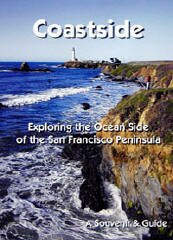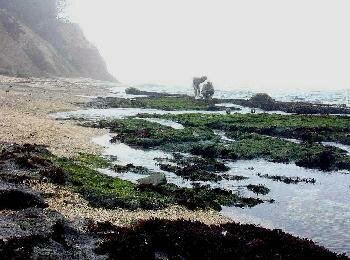Coastside Links & ArticlesLinks to Coastside beaches, parks, and visitor attractions
Beaches, parks and visitor attractions Año Nuevo State Reserve Fitzgerald Marine Reserve http://www.co.sanmateo.ca.us/smc/department/home/0,,5556687_12305999_12328451,00.html Half Moon Bay Coastside Chamber of Commerce & Visitors’ Bureau Mavericks Midpeninsula Regional Open Space District http://www.openspace.org/plans_projects/cpp.asp Monterey Bay National Marine Sanctuary (MBNMS) Native Plants of Montara Mountain Pescadero Conservation Alliance Points of historical interest POST (Peninsula Open Space Trust) Ritz-Carlton, Half Moon Bay San Gregorio Store San Mateo County State Parks http://www.parks.ca.gov/parkindex/results.asp?searchtype=4&county_id=41&searchtext=San+Mateo San Mateo County attractions San Mateo County Museum Spanishtown Historical Society
Books & Maps
The Coast Time Forgot: The Complete Tour Guide to the San Mateo Coast Trails of the Coastside & Northern Peninsula (Trail Map)
Weekend Adventures in Northern California
Articles Shore Leave The Peninsula coastline is dotted with windows into the watery wilderness flourishing just offshore David A. Laws Reprinted from the San Francisco Examiner, Sunday Travel Section, October 8, 2000. "The ocean is a wilderness … wilder than the Bengal jungle and fuller of monsters." - Henry David Thoreau (1865) "They're out there somewhere." I said, pointing to the horizon. "Dad, keep your eyes on the road. We'll look for the Farallones," said my son Mark. Appropriately chastened, I veered away from a 600-foot drop from Highway One into the boiling surf below Devil's Slide. Inspired by Thoreau's quote from "Cape Cod" we had embarked on a weekend exploration of the wilderness frontier at our doorstep; the Pacific Coast shoreline of the San Francisco Peninsula. Having just learned about the elusive islands 27 miles beyond the Golden Gate, I was anxious to glimpse them from this vantage point high above the ocean. I never saw the fog shrouded islands, but we did meet some monsters. The second largest marine protected area in the world, after Australia's Great Barrier Reef, lies just offshore from the crowded Bay Area. Combined, the Monterey Bay, Gulf of the Farallones, and Cordell Bank National Marine sanctuaries cover more than 7,000 square miles. While they are difficult to explore directly, the shoreline offers many windows into this wilderness’ wonders. Until recently tide pools and beaches provided the clearest view. The public activities of the Farallones Marine Sanctuary Association (FMSA) and the new Seymour Marine Discovery Center in Santa Cruz now push the window open a little wider. Gulf of the Farallones National Marine Sanctuary
Farallones Marine Sanctuary Association (FMSA) headquarters on Crissy Field We began our journey at the Old U.S. Coast Guard Station on the San Francisco Presidio. The white-shingled, square, red-roofed structure has stood on the beach since 1890. Today it is the headquarters of the FMSA, dedicated to protecting the ocean surrounding the Farallon Islands. These craggy, fogbound islands are at the center of an immense upwelling of cool, nutrient-rich, deep-ocean water. Dolphins, porpoises, gray, humpback and blue whales thrive here. In the fall, vicious battles rage between two of the ocean's most powerful monsters, great white sharks and migrating northern elephant seals. In the entry hall of the small visitor center, which has programs for school children and whets the appetite of the public for its whale watching, kayaking and other programs, kids were busy examining jars of anchovies, rays, dogfish and other preserved specimens. A life-size mural of a shark dominated the main room. Two girls hesitantly reached for sea stars in a supervised touch and feel tank. We especially enjoyed a complex lace-like display of seaweed. The James V. Fitzgerald Marine Reserve
Exploring tide pools at Fitzgerald Marine Reserve Our next stop was at Moss Beach 15 miles south of San Francisco - one of the richest intertidal ecosystems along the Pacific Coast. Twice a day the teeming underwater world of the James V. Fitzgerald Marine Reserve is exposed to view. Up to 200 species of scuttling, wriggling creatures are stranded by the retreating tide in 30-acres of tide pools. We stepped cautiously across wet, slippery rocks. Foam bubbles flecking the surface of newly formed pools quickly burst revealing a bustling community of crabs, mussels, clams, urchins, starfish, and anemones. A roving naturalist pointed out the differences between mollusks, coelenterates, and echinoderms. Occasionally monsters also visit. Early this year a rare Longnose Lancetfish washed up on the shore. Large dagger-like fangs protrude from the mouth of this voracious predator, whose Latin name translates as "scaleless ferocious serpent." Pillar Point Harbor A few miles further south we stopped at the only sheltered anchorage along this rugged coast. Pillar Point Harbor at Princeton has a colorful history of Prohibition rum running. Today it serves weekend sailors, sport and commercial fishermen, and tourists on whale-watch and Farallon Islands cruises. A hand-scrawled board at Johnson Pier listed boats where we could buy fish right off the deck. Today we could choose from halibut, salmon, rockfish, or lingcod. Seafood establishments crowd the dockside for those who prefer their cuisine ready to eat. After Pillar Point and the suburban sprawl of Half Moon Bay, we entered rolling agricultural country. Brussels sprouts, artichokes, cattle and ancient wooden barns finally outnumbered cars and people. Plump orange pumpkins, the quintessential coast fall crop, lay ready for the Halloween harvest. Pigeon Point Lighthouse Pigeon Point Lighthouse and Hostel Twenty miles south of Half Moon Bay we spied the slender white sentinel of the lighthouse at Pigeon Point. Worth a drive for this destination alone, the 115-foot tall brick tower is a State Historic Landmark. Docents lead climbs up to the 1008-prism, antique Fresnel lens on weekends. (2004 Note: These tours are currently cancelled due to repairs required to the structure.) We carried our bags into one of the three cottages operated by Hostelling International. While the accommodations were somewhat Spartan, these former keeper's quarters have the coast’s most spectacular perch, directly above the ocean. And the price ($16.00 a night) was right.
Hostel entrance gate For much of the summer this spot is cold and shrouded in fog. Tonight, as often in fall and spring, the weather was clear and still. After dinner we joined other guests on an observation deck overhanging the rocky outer point where harbor seals, sea otters and pelicans entertained us. From November to January, this deck is one of the best places along the coast to spot gray whales on their annual 12,000-mile round trip migration from the Arctic to Baja. Ano Nuevo State Reserve Next morning, we set out for Ano Nuevo State Reserve, the largest mainland breeding colony of Northern Elephant Seals. Returning from near extinction, 4,000 or so of these gigantic pinnipeds now mass on this sandy, windswept point between December and March. After the females give birth, bull seals weighing up to 5,000 pounds engage in bloody duels for mating rights, and visits are limited to naturalist-guided walks by advance reservation. Scarred males, calving females, and young pups crowded the beach when our family visited in January two years ago. Today it was deserted, except for a few harbor seals sunning themselves on offshore rocks. Loud barking carried clearly across the channel from Ano Nuevo Island. Our binoculars picked up hundreds of California sea lions waddling uphill on their flippers to their favorite accommodations, the long deserted lighthouse keeper's home. Lonely, undeveloped, and wild, it is tempting to say that the point suggests it hasn’t changed much since Spanish maritime explorer Vizcaino first saw it. But when he sailed past on New Year's Day in 1603 the island had not yet been severed from the mainland by the coastal current. Seymour Marine Discovery Center Finally we met a true monster - one with a heart as big as a Volkswagen bug. In 1979 an 87-foot blue whale washed ashore on Pescadero State Beach, near Pigeon Point. Its huge, bleached skeleton now welcomes visitors to the Seymour Marine Discovery Center at the Long Marine Laboratory of U.C. Santa Cruz. Blue whale skeleton at Seymour Marine Center The center, which opened in March 2000, sits on a bluff overlooking Monterey Bay near Natural Bridges State Beach. Striking, barn-like "industrial-modern" buildings house teaching and aquarium facilities open to the public. The exhibit hall, bursting with multiple tanks, robust control valves, exposed seawater pipes and numerous charts and diagrams, it looked like a working marine lab Aquarium displays elicited and answered such questions as; "Why are the creatures so colorful?" "How fast do they move?" It took us a long time to decide that the hooded nudibranch in the "What's in the Bay Today?" tank was an animal and not a plant. Primo and Pukka, two dolphins that were rejected as psychologically unsuited for the U.S Navy's underwater bomb-detection training, cavorted playfully in their huge circular pool. Our docent told us that after successful graduation at the lab, the Navy wanted them back. They are still here. Maybe UC students burned their draft cards. Raucous barking and splashing emanated from the Sea Lion Cognition Lab. These creatures have extraordinary visual recognition skills. Our guide showed us pictures of dozens of complex symbols that they have learned in order to earn extra goodies. As we drove home, I recalled the skepticism with which I greeted travel writer Paul Theroux' notion that "the shore is the only way to understand the sea - not a voyage on the ocean, but a stroll on the sand. There everything is revealed." After our weekend trek along 100-miles of ocean bluffs and beaches, I understood. IF YOU GO In the summer the weather on the coast can be chilly and overcast. The rest of the year, if it is not raining, it is likely to be bright and clear. Always take layers of clothing. If you plan to explore tide pools, check the tide times and plan to arrive near low tide. In addition to the Pigeon Point youth hostel (www.norcalhostels.org) (650-879-0633) other unique accommodations along the coast include a hostel at the Point Montara (650-728-7177) lighthouse, as well as Costanoa (www.costanoa.com), an upscale tent bungalow campground near Ano Nuevo. Phone: 650-879 1100 The Half Moon Bay Chamber of Commerce at 520 Kelly Avenue, Half Moon Bay, CA 94019 can help you locate more traditional lodgings. (www.halfmoonbaychamber.org) Phone: 650-726-8380 Gulf of the Farallones National Marine Sanctuary Visitor Center. Old Coast Guard Station, end of Mason Street on Crissy Field. Mailing address: FMSA, The Presidio, P.O. Box 29386, San Francisco, CA, 94129. (www.farallones.org) Phone: 415-561-6625 James V. Fitzgerald Marine Reserve - at California Street, P.O. Box 451, Coast Highway 1, Moss Beach, CA 94038. Roving naturalists at low tide on weekends. (www.gladman.com/mb/fitzgerald.html) Phone: 650-728-3584 Pillar Point Harbor. San Mateo County Harbor District, One Johnson Pier, P.O. Box 39, El Granada, CA 94018. (www.smharbor.com/pillarpoint/index.htm) Phone: 650-726-4723 Pigeon Point Lighthouse State Historic Park, 210 Pigeon Point Road, Pescadero, CA 94060 (cal-parks.ca.gov/DISTRICTS/bayarea/ppls281.htm) Phone: 650-879-2120 Ano Nuevo State Reserve, New Year's Creek Road, Pescadero, CA 94060. (www.anonuevo.org) Phone: 650-879-2025. Recorded information: 650-879-0227 Seymour Marine Discovery Center at Long Marine Laboratory, 100 Shaffer Road, Santa Cruz, CA 95060 (www2.ucsc.edu/seymourcenter/) Phone: 831-459-3800 For more information on the area see:
|





